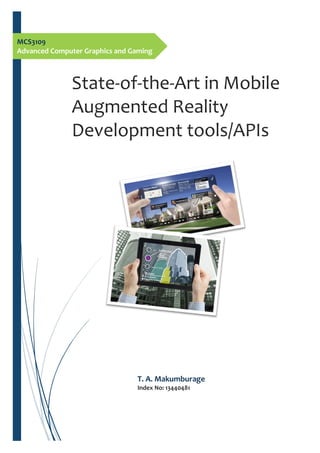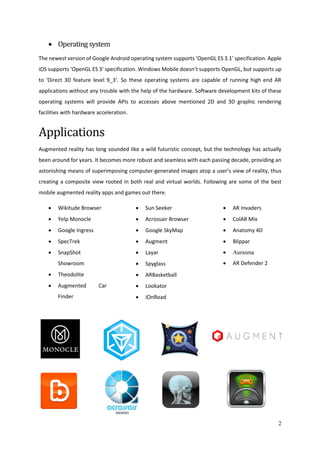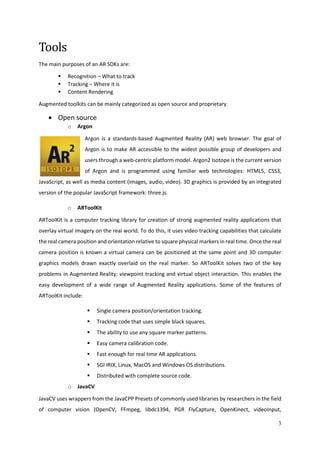Mobile Augmented Reality Development tools
- 1. MCS3109 Advanced Computer Graphics and Gaming State-of-the-Art in Mobile Augmented Reality Development tools/APIs T. A. Makumburage Index No: 13440481
- 2. 1 Mobile Augmented Reality Augmented reality (AR) is related to a more general concept called ŌĆśmediated realityŌĆÖ, in which a view is modified by a computer. As a result the technology enhancing oneŌĆÖs current perception of reality. Augmented reality is used to overlay a synthesized world on top of the real world, which will add meaningful information to help with day-to-day life. Mobile augmented reality is a relatively young technology, but it has already attracted a great deal of hype and skepticism in equal measure. Overlaying digital information onto the real world, viewed through a camera phone, is technically impressive, but the business models and usage patterns are still evolving. Technology In the recent years smartphones are the most developed aspect of the mobile computing paradigm. Latest smartphones are equipped with brilliant cameras, accelerometers, GPS devices, compasses, barometers, step counters and many more sensors to capture contextual data. Thus the smartphones and tables are become suitable AR platforms within few years. ’éĘ Hardware ŌĆ£Turning your phone into the small miracle it truly isŌĆØ This is the motto of famous mobile chip manufacturer, and yes those latest processes are expanded up to 8 cores and speed is up to 2.5Ghz per core. Certainly over powering the standard desktop PCs. Touch inputs and various sensors making the life much easier for AR mobile application developers. A high-end smartphone will include a camera within 8-40 Mega pixels, which can be used as an input to a mobile AR application. Mobile devices are now passed the HD era of the displays, 2K & 4K displays are starting to appear on the market, which will display every bit of detail an AR application can output. Figure 1: Versatility of the mobile chipsets Figure 2 : Qualcomm Snapdragon 800 chipset
- 3. 2 ’éĘ Operating system The newest version of Google Android operating system supports ŌĆśOpenGL ES 3.1ŌĆÖ specification. Apple iOS supports ŌĆśOpenGL ES 3ŌĆÖ specification. Windows Mobile doesnŌĆÖt supports OpenGL, but supports up to ŌĆśDirect 3D feature level 9_3ŌĆÖ. So these operating systems are capable of running high end AR applications without any trouble with the help of the hardware. Software development kits of these operating systems will provide APIs to accesses above mentioned 2D and 3D graphic rendering facilities with hardware acceleration. Applications Augmented reality has long sounded like a wild futuristic concept, but the technology has actually been around for years. It becomes more robust and seamless with each passing decade, providing an astonishing means of superimposing computer-generated images atop a userŌĆÖs view of reality, thus creating a composite view rooted in both real and virtual worlds. Following are some of the best mobile augmented reality apps and games out there. ’éĘ Wikitude Browser ’éĘ Yelp Monocle ’éĘ Google Ingress ’éĘ SpecTrek ’éĘ SnapShot Showroom ’éĘ Theodolite ’éĘ Augmented Car Finder ’éĘ Sun Seeker ’éĘ Acrossair Browser ’éĘ Google SkyMap ’éĘ Augment ’éĘ Layar ’éĘ Spyglass ’éĘ ARBasketball ’éĘ Lookator ’éĘ iOnRoad ’éĘ AR Invaders ’éĘ ColAR Mix ’éĘ Anatomy 4D ’éĘ Blippar ’éĘ Aurasma ’éĘ AR Defender 2
- 4. 3 Tools The main purposes of an AR SDKs are: ’é¦ Recognition ŌĆō What to track ’é¦ Tracking ŌĆō Where it is ’é¦ Content Rendering Augmented toolkits can be mainly categorized as open source and proprietary. ’éĘ Open source o Argon Argon is a standards-based Augmented Reality (AR) web browser. The goal of Argon is to make AR accessible to the widest possible group of developers and users through a web-centric platform model. Argon2 Isotope is the current version of Argon and is programmed using familiar web technologies: HTML5, CSS3, JavaScript, as well as media content (images, audio, video). 3D graphics is provided by an integrated version of the popular JavaScript framework: three.js. o ARToolKit ARToolKit is a computer tracking library for creation of strong augmented reality applications that overlay virtual imagery on the real world. To do this, it uses video tracking capabilities that calculate the real camera position and orientation relative to square physical markers in real time. Once the real camera position is known a virtual camera can be positioned at the same point and 3D computer graphics models drawn exactly overlaid on the real marker. So ARToolKit solves two of the key problems in Augmented Reality; viewpoint tracking and virtual object interaction. This enables the easy development of a wide range of Augmented Reality applications. Some of the features of ARToolKit include: ’é¦ Single camera position/orientation tracking. ’é¦ Tracking code that uses simple black squares. ’é¦ The ability to use any square marker patterns. ’é¦ Easy camera calibration code. ’é¦ Fast enough for real time AR applications. ’é¦ SGI IRIX, Linux, MacOS and Windows OS distributions. ’é¦ Distributed with complete source code. o JavaCV JavaCV uses wrappers from the JavaCPP Presets of commonly used libraries by researchers in the field of computer vision (OpenCV, FFmpeg, libdc1394, PGR FlyCapture, OpenKinect, videoInput,
- 5. 4 ARToolKitPlus, and flandmark), and provides utility classes to make their functionality easier to use on the Java platform, including Android. o DroidAR DroidAR is a framework for Augmented Reality on Android. Location based AR and marker based AR both are supported in DroidAR. This framework can be used for many different scenarios, ’é¦ Footstep recognition & Indoor AR ’é¦ Location based Gaming & Crowdsourcing Framework o ATOMIC Authoring Tool This was created as a front end (Graphic Interface) for use ARToolKit library without having to know programming. It is Multi-platform which allows you to use it in operating systems Microsoft Windows, Ubuntu and Mac OS X. The main motivation of ATOMIC is to provide to the community an open source tool that can be easily modified and that does not require too much technical knowledge to access the augmented reality technology. o Goblin XNA Goblin XNA is a platform for research on 3D user interfaces, including mobile augmented reality and virtual reality, with an emphasis on games. It is written in C# and based on the Microsoft XNA platform. Goblin XNA inherits some of the goals of the earlier Goblin project, but with a shift in emphasis toward core 3D user interface functionality, leveraging the existing functionality of DirectX 3D game engines and development environments. The platform currently supports 6DOF (six degree of freedom) position and orientation tracking using marker-based camera tracking through ARTag with OpenCV or DirectShow, and InterSense hybrid trackers. Physics is supported through BulletX and Newton Game Dynamics. Networking is supported through Lidgren library. Goblin XNA also includes a 2D GUI system to allow the creation of classical 2D interaction components. ’éĘ Proprietary o AR development toolkits ’é¦ PointCloud SDK PointCloud SDK is a free library that lets you build iOS applications that have advanced computer vision capabilities like Simultaneous Localization and Mapping (SLAM) and image detection and tracking. PointCloud Lab has been acquired by Facebook and is joining the Oculus team.
- 6. 5 ’é¦ Vuforia Augmented Reality SDK The Vuforia platform uses superior, stable, and technically efficient computer vision-based image recognition and offers the widest set of features and capabilities, giving developers the freedom to extend their visions without technical limitations. With support for iOS, Android, and Unity 3D, the Vuforia platform allows you to write a single native app that can reach the most users across the widest range of smartphones and tablets. Some of the new features of new Vuforia 4.0 are, o Object Recognition Object Recognition, one of our most requested features, enables apps to recognize and track a wide range of objects. This new capability is ideally suited to bring toys and consumer products to life. o Vuforia Object Scanner The Vuforia Object Scanner is an Android app that makes it easy to create object targets. As you scan an object, the app provides real-time visual feedback on the target quality, coverage, and tracking performance, allowing you to test and adjust the target even before starting app development. o iOS 64-bit Support Support for building 64-bit apps on iOS is now available, giving you the ability to create compelling user experiences on compatible iOS devices that are more responsive and richer in graphics. o AR content management systems ’é¦ Metaio Creator The metaio Creator is augmented reality software that allows users to create a complete AR scenario without specialized programming knowledge through a drag and drop interface. ’é¦ BuildAR.com Launched in 2009, buildAR was the world's first AR Content Management System (AR-CMS). The first version launched as a test to see if people were interested in being able to create their own augmented experiences. It turned out you were! So then we got busy developing a production version and officially launched the new and improved buildAR at the Augmented Reality Event in Silicon Valley in May 2011.
- 7. 6 ’é¦ Catchoom CraftAR The SDKs licensed by Catchoom Technologies offer tools to connect your branded mobile application with the CraftAR service in the cloud. There are two SDKs available for different operating systems and devices. Following are some of the features of the CraftAR SDK. ’éĘ Camera capture management ’éĘ Cloud Recognition ’éĘ 3D Object Tracking ’éĘ AR content rendering in AR view ’éĘ Automatic download of AR content stored online ’éĘ AR content description parser ’éĘ AR content type extension ’é¦ Hoppala Augmentation With more than 7000 registered developers Hoppala Augmentation is the worldŌĆÖs largest content platform for geo based augmented reality. It seamlessly publishes your content to all three major AR browsers: Layar, Junaio and Wikitude. Create once and publish everywhere. The graphical web interface makes it very easy to build geo referenced content with just some mouse clicks, there is no software installation required and no coding needed at all. ’é¦ Webcam Social Shopper The Webcam Social Shopper, often referred to as virtual dressing room software, debuted online in June 2009 and was created by Los Angeles based software company, Zugara. Cited initially as an "Augmented Reality Dressing Room", The Webcam Social Shopper allows online shoppers to use a webcam to visualize virtual garments on themselves while shopping online. The software also uses a motion capture system that allows users to use hand motions to navigate the software while standing back from their computer. o End-to-end branded app solutions ’é¦ Alive app It uses the mobile device's video camera to recognize pre-trained images and overlay an image, video or 3D content on the recognition of image. Aliveapp is the only augmented reality application in the world to be available on the four major platforms (Android, iOS, Windows, Blackberry Symbian and Java) and is augmenting the complete newspaper. It is the first publicly available application designed for a Newspaper Giant that used a location-based approach to Augmented Reality along with the image based Augmented Reality.
- 8. 7 ’é¦ Aurasma Aurasma is HP Autonomy's augmented reality platform. It is available as an SDK or as a free app for iOS and Android mobile devices. Aurasma's image recognition technology uses a smartphone's or tablet's camera to recognize real world images and then overlay rich media on top of them in the form of animations, videos, 3D models and web pages. Both businesses and individuals use Aurasma to create and share their own augmented reality experiences as well as to discover hidden digital content around them. Teachers are among the most active group using the platform. ’é¦ Junaio Junaio is an Augmented Reality browser designed for 3G and 4G mobile devices. It is developed by Munich-based Company, Metaio GmbH. It provides an API for developers and content providers to generate mobile Augmented Reality experiences for end-users. The smartphone app as well as the API are free to use. Currently, it is available for Android and iPhone platforms. Junaio is the first augmented reality browser that has overcome the accuracy limitations of GPS navigation through LLA Markers (latitude, longitude, altitude marker). ’é¦ Layar The layar browser makes use of the Accelerometer, built-in camera, compass and GPS sensors. These are used together to identify the userŌĆÖs location and field of view. From the geographical position, the various forms of data are laid over the camera view like inserting an additional layer. Data in the browser comes in the form of layers. Layers are REST web services serving geo-located points of interest in the vicinity of the user. Layers are developed and maintained by third parties using a free API. Layar as a company is responsible for their validation in the publication process. ’é¦ Nokia City Lens Nokia City Lens, is an augmented reality (AR) software that gives dynamic information, through the phoneŌĆÖs camera display, about users' surroundings such as shops, restaurants, and points of interest, shown as virtual signs overlaid on or above buildings. A commercial Beta version was release in 2013. It also has free of charge turn-by-turn voice guided navigation, Nokia Drive 3.0, which can also be used without internet connection using preloaded maps. It's also possible to de-clutter the
- 9. 8 surroundings: version 1.5 has a "Sightline" feature where the user can narrow her view to just whatŌĆÖs in her direct line of sight, making it easier to spot interesting places. ’é¦ Wikitude Wikitude is a mobile augmented reality software which is developed by the Austrian company Wikitude GmbH (formerly Mobilizy GmbH) and was first published in October 2008 as freeware. It displays information about the users' surroundings in a mobile camera view, including image recognition and 3d modeling. Wikitude was the first publicly available application that used a location-based approach to augmented reality. For location-based augmented reality the position of objects on the screen of the mobile device is calculated using the user's position (by GPS or Wi-Fi), the direction in which the user is facing (by using the compass) and accelerometer. The location-based augmented reality view provides a direct view of reality enhanced with additional, computer-generated content, as opposed to a conventional map, which provides an abstract view from above. A central element in the Wikitude World Browser is the location. Compared to regular web pages, where the location of the user plays a minor role, Wikitude World Browser is optimized for mobile location-based usage. Content in the Wikitude World Browser is mostly user generated. Content can be added by a web interface, by KML, and ARML. In addition, Web services are available to register the delivery of dynamic data. Wikitude is a W3C member and OGC member and is working to develop ARML further as part of a W3C ARML project. ’é¦ Word Lens Word Lens is an augmented reality translation application from Quest Visual. Word Lens uses the built-in cameras on smartphones and similar devices to quickly scan and identify foreign text (such as that found in a sign or a menu), and then translate and display the words in another language on the device's display. The words are displayed in the original context on the original background, and the translation is performed in real-time without connection to the internet. ’é¦ XARMEX XARMEX (short for: eXtended Augmented Reality for Military EXercise) is an augmented reality-aided close quarterŌĆÖs combat simulation system, combining motion detection hardware with image overlay/stabilization software to create realistic military simulation environments and computer games.
- 10. 9 Comparison SDK Purpose Tracking Platform Graphics Cloud GPS License Qualcomm Vuforia 2D Images, Markers NFT, Marker, Text iOS, Android Unity3D & Alt. yes no Free Metaio SDK 2D Images, GEO, 3D, Anywhere NFT, GPS, 3D, SLAM iOS, Android Unity3D & Alt. yes yes 0-$10,000 Wikitude SDK 2D Images, GEO GPS, NFT iOS, Android, Blackberry HTML, Proprietary yes yes 0-$2,300 Layar SDK 2D images NFT, QR iOS, Android Proprietary yes no $3,250/app/ yr. + $20/page 13th Lab Point Cloud 2D Images, 3D, Anywhere NFT, 3D, SLAM iOS, Android Unity3D & Alt. no no 0-$5,000 AR Toolkit 2D Markers 2D Images NFT, Marker iOS, Android Unity3D & Alt. no no $0 (GPL) - $2,495 + royalty HP Aurasma SDK VFX, Videos on 2D Images NFT iOS, Android Proprietary yes yes Per click Obvious Engine 2D images, Cylinders NFT, Cyl. iOS, Android Unity3D & Alt. no no $8000/app/p latform String Framed 2D images Framed Image iOS Unity3D & Alt. no no $499 - $8000/app/y ear References 1. Wikipedia. [WWW] [Feb 2015, 20] http://en.wikipedia.org/wiki/List_of_augmented_reality_software. 2. Augmented World Expo. [WWW] [Feb 2015, 23] http://en.wikipedia.org/wiki/List_of_augmented_reality_software. 3. ║▌║▌▀Ż Share - Mobile AR SDK Comparison and Tutorial [WWW] [Feb 2015, 25] http://www.slideshare.net/patrickoshaughnessey/2013-0603augmented- worldexpomobilearsdktutorial










![9
Comparison
SDK Purpose Tracking Platform Graphics Cloud GPS License
Qualcomm
Vuforia
2D
Images,
Markers
NFT,
Marker,
Text
iOS, Android Unity3D &
Alt.
yes no Free
Metaio
SDK
2D
Images,
GEO, 3D,
Anywhere
NFT, GPS,
3D, SLAM
iOS, Android Unity3D &
Alt.
yes yes 0-$10,000
Wikitude
SDK
2D
Images,
GEO
GPS, NFT iOS,
Android,
Blackberry
HTML,
Proprietary
yes yes 0-$2,300
Layar SDK 2D images NFT, QR iOS, Android Proprietary yes no $3,250/app/
yr. +
$20/page
13th Lab
Point
Cloud
2D
Images,
3D,
Anywhere
NFT, 3D,
SLAM
iOS, Android Unity3D &
Alt.
no no 0-$5,000
AR Toolkit 2D
Markers
2D Images
NFT,
Marker
iOS, Android Unity3D &
Alt.
no no $0 (GPL) -
$2,495 +
royalty
HP
Aurasma
SDK
VFX,
Videos on
2D Images
NFT iOS, Android Proprietary yes yes Per click
Obvious
Engine
2D
images,
Cylinders
NFT,
Cyl.
iOS, Android Unity3D &
Alt.
no no $8000/app/p
latform
String Framed
2D images
Framed
Image
iOS Unity3D &
Alt.
no no $499
-
$8000/app/y
ear
References
1. Wikipedia. [WWW] [Feb 2015, 20]
http://en.wikipedia.org/wiki/List_of_augmented_reality_software.
2. Augmented World Expo. [WWW] [Feb 2015, 23]
http://en.wikipedia.org/wiki/List_of_augmented_reality_software.
3. ║▌║▌▀Ż Share - Mobile AR SDK Comparison and Tutorial [WWW] [Feb 2015, 25]
http://www.slideshare.net/patrickoshaughnessey/2013-0603augmented-
worldexpomobilearsdktutorial](https://image.slidesharecdn.com/literaturesurveyreport13440481-150226112114-conversion-gate02/85/Mobile-Augmented-Reality-Development-tools-10-320.jpg)